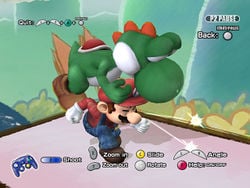Pause
Pausing is an action performable in all Super Smash Bros. games that stops all action on the screen until the pause button is pressed again.
When a game is paused, all action on the screen stops, giving players the opportunity to take a break in the middle of a match. However, pausing the game for minor reasons is generally frowned upon as it can disrupt gameplay, though there are, of course, exceptions. Still, pausing can be disabled in the VS mode rules (as it is in tournaments).
In Super Smash Bros. Brawl, game elements (such as Final Smashes or the next character in line during a mid-match character swap) continue to load when the game is paused. This can be abused, such as making events like Co-Op Event 5: The Yoshi Team of 50 easier (by shortening loading time compared to time remaining). It is difficult to tell whether this is also the case in Melee, but as loading in general is faster and not nearly as noticeable, it would have much less useful effect.
When in the Subspace Emissary, Player 2 can not pause the game. Instead, pressing the Start button causes the character to Space Jump.
Pausing is also possible during a Subspace Emissary cutscene. If the pause button is pressed, the cutscene will temporarily stop, and an option will be displayed at the top-right of the screen to 'skip movie' by pressing the 2 button on the Wii Remote or the A button on a Wii Remote with Nunchuk, a Classic Controller, or a GameCube controller.
In Melee and Brawl, pausing does not stop the time counter during Target Smash! outside of Classic Mode.
Interestingly, whenever Super Smash Bros. for Nintendo 3DS is paused, the quality of the models and textures for characters noticeably increases, presumably to allow for higher-quality snapshots to be taken.
Match reset
Pausing also allows for players to abandon or quit the match. For the first three games, pressing a certain button combination would do so, while in the 3DS version of Smash 4, a button on the touch screen must be pressed instead. Quitting in this way does not save any data of the game within the save file (such as KOs and time allotted, however, the number of aborted matches is recorded), and in Melee, combatants are not rewarded with bonuses. If the pause button is part of a combination, it must be pressed last, or the game will simply unpause; the other three buttons many be held in any order.
- Super Smash Bros.:
+
+
+
- Super Smash Bros. Melee:
+
+
+
- Super Smash Bros. Brawl:
- Wii Remote sideways:
 +
+ +
+ +
+
- Wii Remote + Nunchuk:
 +
+ +
+ +
+
- GameCube controller:
+
+
+
- Classic Controller:
 +
+ +
+ +
+
- Wii Remote sideways:
- Super Smash Bros. for Wii U:
- GamePad/Wii U Pro Controller:
 +
+ +
+ +
+
- Wii Remote sideways:
 +
+ +
+ +
+
- Wii Remote + Nunchuk:
 +
+ +
+ +
+
- GameCube controller:
+
+
+
- Classic Controller:
 +
+ +
+ +
+
- GamePad/Wii U Pro Controller:
Additionally, some single-player modes in games of the Super Smash Bros. series allow players to retry stages within the pause menu, without having to instead go back to the character selection screen.
- Super Smash Bros.:
- Super Smash Bros. Melee:
- Super Smash Bros. Brawl:
- Super Smash Bros. for Wii U:
- GamePad/Wii U Pro Controller:
 /
/
- Wii Remote sideways:

- Wii Remote + Nunchuk:

- GameCube controller:
- GamePad/Wii U Pro Controller:
Camera
Pausing also allows the players to look around by adjusting the camera angle and zooming in. In Super Smash. Bros, tilting the analog stick will make the camera rotate around the current target, limited by angle, but not by solidity. In other words, the camera will stop rotating after a certain angle, but it has no collisions, which means that it can be moved inside walls.
Melee expanded the camera controls further. Pressing L or R will switch targets. Pressing X or Y will zoom in and out, up to a certain point.
In Brawl these controls were further developed, now allowing the player to take snapshots while the game is paused. In addition to Melee's features, the camera can also be panned with the C-Stick, and doesn't need to target on a player. An unrestricted camera hack has also been created to eliminate the camera's restrictions.
In tournaments
Pausing is often manually disabled in tournaments via the ability to modify the Rules. This is not always the case, however, and in some tournaments, players are allowed to pause the game, albeit only under certain circumstances; in Brawl's official ruleset, players who pause must have the situation monitored by the Tournament Organizer, who then decides on proper course of action. In most cases, a match continues with no infractions; pausing to interrupt combos or otherwise disorient the opponent, however, can cause players to lose one or even two stocks. Similar rules exist for the rulesets of other games.
Match Resets are sometimes allowed in tournament rulesets as well, though there do exist limitations. Players can reset matches if the match goes particularly poorly in the limited time slot at the start of the match, and some Tournament Organisers do sometimes allow players to reset matches if the match goes poorly in general, which causes the match to not count as a win or loss; this, however, is generally limited to only one match per tournament round. Players who reset matches with no forewarning are often immediately disqualified from the tournament.
Gallery
- DKstare.jpg
Pausing in Super Smash Bros.


